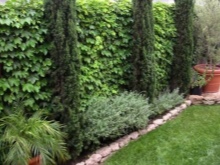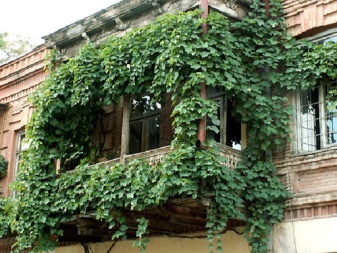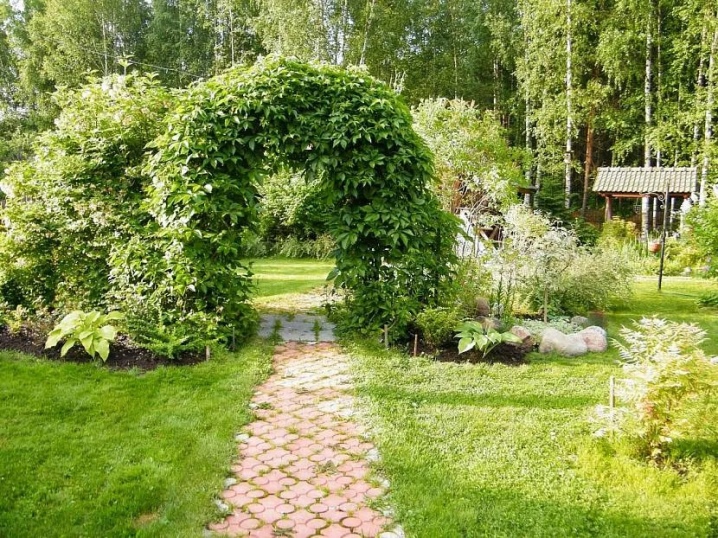Girlish grapes in landscape design

A deciduous vine called maiden grape has been widely used in landscape design since the 17th century. She is considered a real lifesaver in decorating unsightly buildings and decorating unkempt gardens.






Features, pros and cons
Scientists have not been able to establish for certain the time and place of the appearance of wild grapes. Presumably, China or North America became its homeland, and from there it spread to other countries and continents. The only reliable fact is that in the 17th century, the liana became widespread as a decorative culture, at the same time its biological description was created.
So what are wild grapes? It is a deciduous vine, the official name is parthenocissus. Under natural conditions, it grows up to 20-25 m, lifting along vertical supports is carried out due to antennae with suction cups. The leaves are palmate-complex, the shade of the leaf plates is rich emerald. The inflorescences are rather inconspicuous and bear no aesthetic value.
With the arrival of autumn storms, the leaves change their color to crimson-scarlet and burgundy. In the same period, colorful clusters of blue-black berries begin to ripen.
They contain oxalic acid, so people do not eat them, but feathered friends will not refuse to feast on them on cold winter days.



Wild grapes have become a highly resilient culture among landscape designers. Its advantages include the following features.
- Resistance to subzero temperatures. Liana easily tolerates both cold winters and returnable spring frosts, does not require shelter even in cold regions.
- High growth rate. In one season, the area occupied by this vine increases two, and sometimes three times. A couple or three years is enough to completely wrap around a garden object. At the same time, wild grapes do not require any support - in this capacity, the wall of the house, a gazebo or a fence made of chain-link are quite suitable for it.
- Practicality and usefulness. The crown of wild grapes is dense. Thanks to this, it protects the wall material from direct ultraviolet rays and thereby contributes to maintaining a favorable indoor microclimate during the hot summer months. Also, the plant has the ability to dry out the soil near the foundation. In addition, it is often used to camouflage inconspicuous farm buildings.
- Unpretentiousness. The plant has no special requirements for the quality and structure of the soil. It is resistant to most pests and diseases, it does not need special care and regular feeding. Wild grapes will grow successfully even if a person does not take care of the grapes at all.






The disadvantages include the ability to fill the entire nearby space in the shortest possible time, displacing neighboring cultivated plants. The most active shoots can even damage the integrity of the roof and cause leaks. There are cases when young shoots of maiden grapes filled the gutter and caused clogging of the drains.
Using a liana to camouflage buildings, you need to remember that the stems and leaf mass are quite heavy. Such a load is enough for a flimsy structure or an unreinforced fence to collapse.
To get a lush, uniform and at the same time safe cover, you will have to cut off excess shoots from time to time, thus adjusting the direction of growth.



How to use
Wild grapes are distinguished by carved leaves, due to which the braided surface is both dense and embossed at the same time. Throughout the summer months, the vine pleases with its graceful foliage shape, and in the autumn time, the advantage is created due to a bright and colorful color effect. The plant is ubiquitous in garden plots. Its use is based on one of the following ideas.


Hedge
Girly grapes are considered one of the easiest and cheapest ways to decorate an unsightly fence. Liana is used to create a decorative hedge in the local area or planted from the outside.
The result is a stylish fencing - in both cases, it is very important to take care of sufficient strength and strength of the supporting structure.


Vertical decor of buildings
The classic use of maiden grapes is to mask unsightly walls of a residential building, garden kitchen, or any other building on the site. Its only inconvenience is associated with the rapid growth of vines, it must be kept under constant control.
If you do not pay enough attention to this issue, then the shoots in a matter of weeks will drown out the flower beds and turn the house area into a real impassable jungle.


Decoration of balconies and terraces
Maiden grapes are grown not only in gardens, but also on balconies and terraces. Its branches twine around partitions and thus create a living wall. This improves the aesthetics of the extra space, and also makes the living area cooler and darker. This vine is very hardy, so you can grow it in regular containers.
The only thing you have to do in this case is to make nutritious feeding from time to time.


Horizontal landscaping
Traditionally, girlish grapes are used for decorative vertical gardening. However, it can also be used horizontally. Such landscape design is not widespread, but it gives a rather unusual effect.
Due to its exceptional survivability, unpretentiousness and rapid growth, liana is often planted along highways. There, it easily withstands car exhaust and absorbs harmful carbon dioxide. Wild grapes can be planted as a ground cover near a rocky slope. It will grow over its surface and thus form a decorative carved carpet.

Care
Wild grapes are one of the most unpretentious plants. Caring for him does not take much time. Basically, it comes down to the formative pruning of excess shoots and their fixation in the required direction. Once a season, usually in April-May, sanitary pruning is carried out, all dry shoots are removed and nitrogen-containing fertilizers are applied to the soil. In the summer, as the soil is compacted, loosening and weeding can be carried out.
As for watering, the water that the plant receives in the form of precipitation is enough for the liana. If the summer is dry, then 3-4 irrigations are better.
On the territory of Russia, mainly frost-resistant varieties of maiden grapes (tri-pointed and five-leafed) have become widespread - they do not require additional shelter for the winter. And even if the liana freezes in severe frosts, it will quickly recover due to dormant buds.



Beautiful examples
You can decorate with grapes on your local area absolutely everything that you have. If your garden has an unsightly barn, you can make it that much more aesthetic. Surely many are familiar with the situation when in the middle of the site a wreck is located and spoils the whole decor with its appearance.Demolishing it and building a new structure is not an option, but the situation can be corrected. Just plant wild grapes around, and in a couple of years the building will look truly luxurious.


In the Middle Ages, grapes twined around Gothic castles. Nowadays, creating an analogue of such a decor is not difficult - for this you just need to plant a few bushes of grapes under the walls of your house. There is no need to make any additional supports, due to the antennae with suction cups, it will crawl on its own.
Tip: If there are cracks in the walls, then the grapes will definitely be taken into them - this beauty can be very destructive. In order to prevent damage to the structure, before growing grapes, throw a net on the wall, so you will protect your residential building.
In this simple way, you will create a real gothic atmosphere on your site. And if at the same time you build a kind of columns on the walls and an elevation above the roof from reinforcement, then you can create a fairy-tale castle of the era of King Arthur with the help of a vine with a minimum of costs.

The idea of creating a grape ball is considered very original. Such decoration of landscape design will delight passers-by and the envy of neighbors. Be sure - soon more than one such ball will appear on your street. It is very easy to make it. For work, you only need a plastic drain pipe of a large diameter, several metal-plastic pipes, fasteners for them, as well as wire.
First, you need to bend the reinforced plastic pipes and shape them into a circle. The ends are fixed with special fasteners or soldering. Usually two pieces of pipe are enough to form the four sides of the ball. When creating a ball of impressive size, you will need a three-piece pipe structure.
Next, you need to wrap the scarf a little with thick wire. You just need to create only approximate outlines, the structure will acquire a more distinct rounded shape during the formation of the vine. Then dig a pipe into the ground next to the ball and plant four bushes of grapes under it, one on each side.
Very soon, young shoots will sprout outward through the pipe and begin to circle your structure. All you need to do is simply mold as you grow. You should have a very effective and beautiful ball.

If you need a place where you can retire in the cool and shade in the summer, make a canopy braided with wild grapes. To do this, first form a structure out of reinforcement, wood, mesh, or any other material. Plant a vine near it, and in a year you will get a cozy shady area.
As a frame for wild grapes, you can use a trellis - it can be metal or wooden. Keep in mind that wooden structures in garden areas will need a special impregnation to protect the structure from water and rot.


An arch wrapped in a liana looks very impressive in the country; it can be installed over a garden path or placed as an independent decorative element. For the successful implementation of this concept, the strength of the structure is of fundamental importance. To maintain its decorative appearance, it is necessary to carry out formative pruning from time to time.

Wild grapes are often used to equip pergolas - gazebos with a mesh roof. The curly liana forms a living roof on wood or vinyl sheathing. It takes 3-4 years to transform the structure into a cozy gazebo.

Liana in garden design is often combined with other ornamental crops. So, the composition of maiden grapes and clematis with its large flowers of bright saturated shades comes out very picturesque.
However, when choosing such landscaping, it must be borne in mind that clematis loves illuminated areas.














The comment was sent successfully.